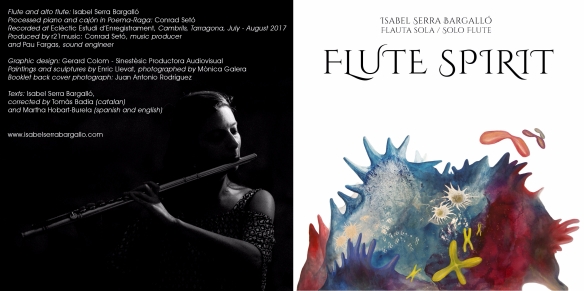
The sound of the flute flows from within the body towards the instrument and from the instrument to the outside. The air vibrates inside the tube moved by the breath and produces the sound. The breath is moved by the inner energy: chi for the Chinese, prana for the Hindus. So the sound is moved by energy and arises from the breath, an essential life factor together with the heartbeat. Both respond to an alternation, to a cyclical rhythm of expansion and contraction, fullness and emptiness. Everything responds to cycles in Nature: day and night, the passage of the seasons, wet times and droughts… The human being responds to cycles in the same way as the rest of the universe does. The entire universe is within the human being, as we also find it symbolically in music. All the multiplicity of musical notes develops from sound. The range of tones, their variety in pitch, color, dynamics and articulation represents the diversity of all that is manifested.
This record contains a selection of pieces for solo flute which I have been incorporating throughout my life cycle. Each one has a special meaning for me. Some of the pieces are well known, and I studied and played them in exams and competitions at the beginning of my career; others were dedicated to me or composed for me more recently. There are pieces that evoke the sound of wind instruments from traditional cultures, such as Japanese bamboo flutes or Native American flutes. There are also pieces of Oriental inspiration, more spiritual. As a whole, the repertoire on this CD is related to what playing the flute means to me — an experience in which I become conscious of life without thinking about it. I recorded in a meditative state, and that is what I would like to transmit to the listener.
Image, op. 38 (1939) by Eugène Bozza is a fresh, lively and sparkling piece, like spring. It was one of the first solo flute compositions I learned and has been with me since my youth. It represents a starting point, and that is why I chose it to open this record.
From the alternation of origins and the present comes the situation in the second place of two pieces by the Canadian composer Jonathan G. Bayley: …From Within (1981) and Music for Pan (1976). In the late 1970s and early 1980s Bayley studied at the Banff Centre for Arts and Creativity (Banff, Alberta, Canada) and it was the jazz flutist Paul Horn who introduced him to the alto flute. The first of the pieces seeks an inner sound, integrated with the breathing, and the second one, dedicated to Jeanne Baxtresser, shows Baroque reminiscences in its form and articulation, while alluding to the mythological legend of Pan and Syrinx, so closely linked to the flute repertoire.
Benjamin Britten composed his Six Metamorphoses after Ovid, op. 49 (1951) for solo oboe inspired by various Greek and Roman mythological figures. Pan belongs to this set of pieces and I decided to play the flute version in 2013 as a tribute to the 100th anniversary of the composer’s birth. I like to play this piece along with the famous Syrinx (1913) by Claude Debussy. I look for the harmonic richness of a double reed instrument in Britten, and the sonority characteristic of the Pan flute, or syrinx, in Debussy.
Toru Takemitsu deeply loved the flute and the alto flute and they played a prominent role in his works. Air (1995) represents the heritage of Debussy’s impressionistic style. It was dedicated to Aurèle Nicolet, a leading flute player who passed away in 2016, as a birthday present, and is the last piece the Japanese composer wrote shortly before his own death.
In the ancient tradition of Japan it was believed that the sound of the flute could reach the souls of the dead; breathing into the flute made it possible to communicate, through sound, with something beyond. Kazuo Fukushima imbues his music with a strong influence of ancestral Japanese culture and philosophy, which is evident in the sonorities and meaning of his Requiem (1956).
Other ancestral sonorities, this time from Native North American music, can also be heard in Kokopeli (1990), by Katherine Hoover. I personally met the composer in 2012. I worked on this piece with her and later played it at a lecture she gave at the Barcelona Liceu Conservatory on February 29th of the same year. Kokopeli the flute player was a great mahu, a legendary hero of the Hopi. He is said to have led the migration of his people through the Southwest, the sound of his flute echoing through canyons, valleys and mountains. The piece captures this sense of spaciousness and the strong connection the Hopis felt to the land.
Another composer I have had the pleasure of working with is Marian Marquez, who dedicated Abril (2016) to me. I premiered this piece in the summer of 2016 in a concert that was part of the Bouquet Music Festival in Tarragona. The piece evokes sunrise, the song of birds, some insects, the wind, the brightness of midday, the rain and more, describing much of what Nature brings us in this month of the year.
My collaboration with the composer Conrad Setó is reflected on this record through two of his pieces. The first of them, Narració (2010), was written originally for a Catalan folk wind instrument called the gralla. The score inspired me to experiment with the alto flute and I decided to make my own version of it, resulting in a very different sound. The second piece, Poema-Raga (2017), for solo flute and electronics, is a new composition written especially for me. Working directly with the composer and being present throughout the creative process was a new and enriching experience that opened new paths to the future.
Isabel Serra Bargalló, summer 2017
Print: Flute Spirit (english)

beautifully expressed
LikeLiked by 1 person
Thank you!
LikeLike